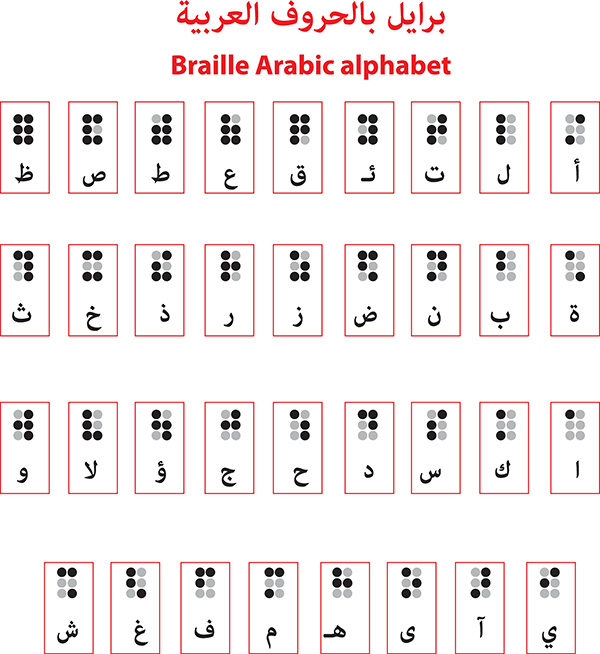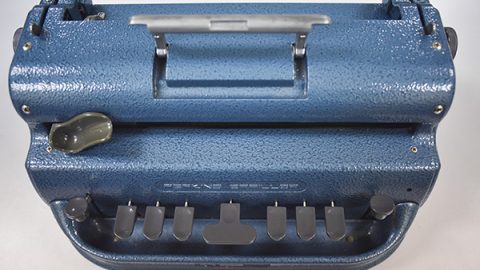What Is Braille?
What Is the Braille Method?
Braille is a method of reading and writing that relies on touching prominent dots that the blind recognize once they pass their fingers over them. The method was invented in the mid-19th century and got its name from the name of its French founder Louis Braille. Braille helped blind children to learn how to read and write and adults who lost their ability to read, due to blindness or vision impairment, continue to enjoy access to books, magazines, and other knowledge resources.
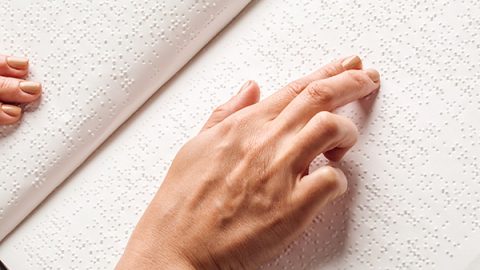
Although Braille uses touch, sighted people can read it with their eyes as well.

Braille characters are written braille through bands called braille cells so that each cell mostly forms one character. Depending on the shape of these dots within the cell, each character is different. The maximum number of dots per cell is six dots, and the minimum number is one dot.
Each cell is a small rectangle with two columns and six dots. Each of the six dots is numbered by its location in the cell. The left column includes dots 1, 2, and 3, and the right column contains the dots 4, 5, and 6.

For example, the letter “أ” is written by showing the first dot — located at the top left of the cell — alone, while hiding the rest of the dots⠁.
With regard to the letter “ب”, it is from the first and second dots without the rest of the dots ⠃; if the cell is left blank, it means there is a blank space between words.
Thus, 64 different formulas can be obtained using one or more dots within a single cell, which is enough to accommodate all letters, punctuation, and other symbols.
The blind need one finger to read braille, usually the index finger, which is the most sensitive human finger. Some blind people rely on both hands to speed up reading. It is worth mentioning that the braille reader is usually a little slower than the normal font reader, with some statistics stating that an average braille reader can read at a rate of 125 words per minute, while a proficient reader may read more than 200 words per minute.
Braille is not a language, as some call it, but it is a code that enables blind people to read and write in different languages such as Arabic, English, and French. It is worth mentioning that braille in Arabic is read from left to right and not the opposite as it should be in Arabic text, this is to be in line with the braille reading format of all languages.
How to write Braille?
There are two main methods of braille handwriting, either by a ruler and pen or by a Perkins Brailler.
Write with a ruler and pen
The blind may write using a braille pen, which is a wooden pen with a pointed metal tip, and a braille ruler, which is a template with braille-sized spaces designed to allow the blind to write inside them.
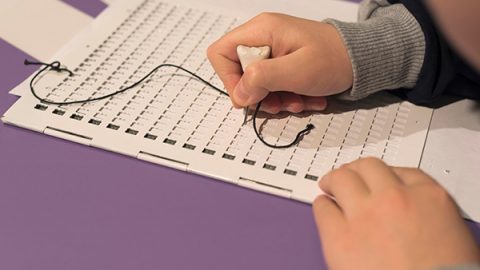
The blind person may fix the paper on the ruler and then hold the pen and start pressing it down in the places where he wants to place dots, and once he finishes writing a cell, he moves to the adjacent cell to write the dots of the letter he wants. If the line ends, he starts writing on the next line. The pen will create holes in the paper so that these holes form braille dots on the opposite side of the paper.
Writing in this way is done from right to left, for example, if the blind want to write the letter “أ”, they will press the pen at the far right of the cell from the top and then leave the rest of the cell without pressing anywhere else in it and move to the next cell and so on.
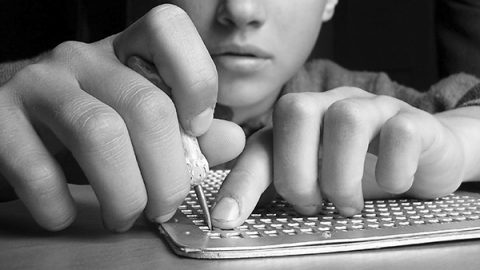
The written letters appear on the opposite side of the paper, so the blind cannot read what they are writing while writing, but they have to remove the paper from the ruler first and then turn it over to the other side to be able to read.
This method is quite old, but it is inexpensive and can be useful for making some quick notes, such as writing on binders of papers and documents.
Writing using a Perkins Brailler
The blind person uses a mechanical typewriter that contains six buttons for entering the six dots, a button for leaving a space, a button for backward space, and a button for scrolling to the next line.
The dots writing buttons from left to right are 3, 2, and 1 on the left side, and these dots are written with the left hand. While in the middle there is the blank space button, which is usually larger than the dots buttons, then the dots 4, 5, and 6 are on the right side, arranged from the left, and these dots are written with the right hand.
It is noticed that in many cases it requires pressing more than one button at the same time to write the dots to be entered in one cell, for example, to write the letter “ب”, the button of the first dot must be pressed with the button of the second dot at the same time to write the dots 1 and 2 which form the letter “ب”. This method is the easiest and most popular, and it has been adopted as an input pattern for writing in electronic braille notepads.
Braille printers
Braille printers are connected to computers that print the plain text on the computer into braille. It is the fastest way to get paper braille text. However, this technique is a bit expensive. Printers differ according to their size, speed, and capabilities. There are small printers intended for simple personal or office use, and there are huge, super-fast printers used by large institutions to print books, school curricula, and so on.
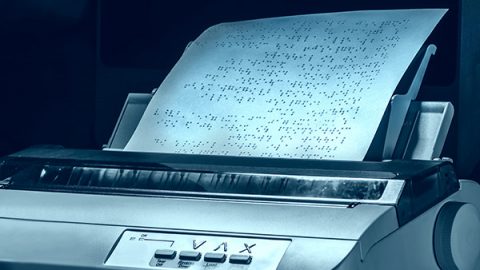 A
A
A Braille printer needs a computer program that translates text and sets regular formats from plain font into braille and then sends it to the printer to convert it on paper. The files are also usually checked and edited before printing by a braille expert, to ensure that the braille produced is of high quality, accurate, error-free, and suitable for readers.
Note: The paper used to write braille must be of the thicker type, as it is usually Bristol paper, and it is more expensive than the paper used in regular writing, so that it withstands pressure and allows dots to protrude on it, much like the thickened paper used to print certificates.

E-Display
Braille is no longer only read on paper. Electronic devices were invented to transfer smartphone and computer-based content onto an electronic display. When reading a document on a computer, the blind person passes his finger on the line and reads its content, and when he is done reading it, he presses a certain button to display the next line and so on until he finishes reading the whole document.
Some of these devices contain built-in programs such as text and notes editors, and they contain a Perkins-style keyboard through which the blind can enter text into the computer or take notes through the device itself, and these devices are known as electronic braille notebooks.
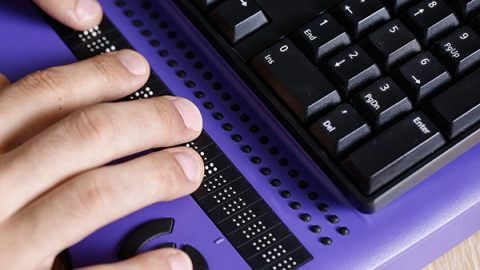
Braille was and remains the most important literacy tool for the blind. There is no doubt that the blind today are luckier than the blind of the past, thanks to braille, and thanks to modern technologies that have opened up great prospects for learning.

